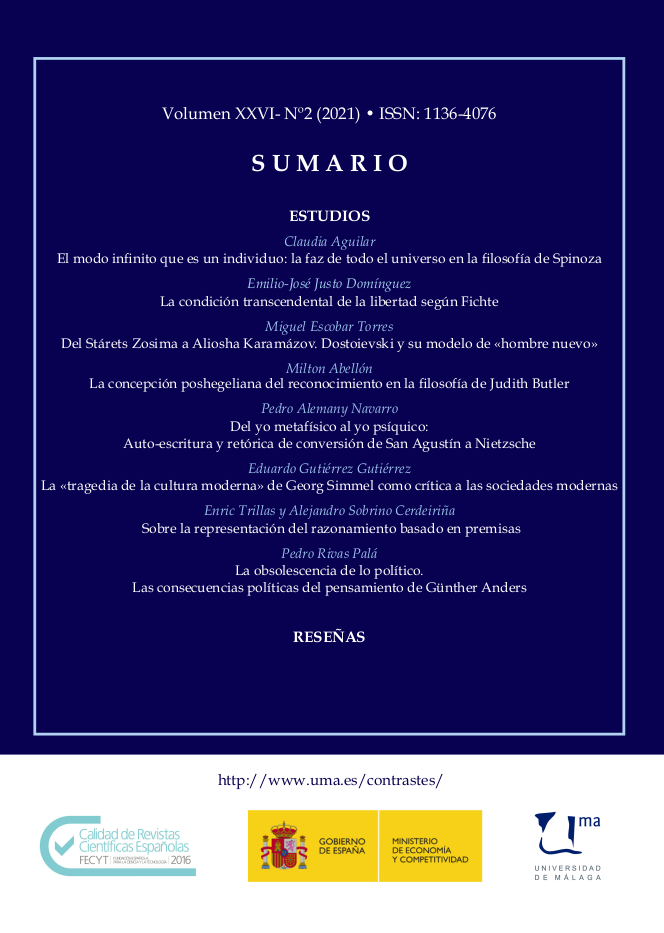From Stárets Zosima to Aliosha Karamázov
Dostoevsky and his Model of ‘New Man’
DOI:
https://doi.org/10.24310/Contrastescontrastes.v26i2.10098Keywords:
hesychasm, Stárets Zosima, Aliosha Karamazov, new manAbstract
In this paper I trace back the origins of Dostoevsky’s spirituality, following an almost continuous line from the Desert Fathers to the startsí in the Russia of the XVIII-XIX centuries. During this period, I study the consequences of the XV century controversy between Nil Sorsky and Iósif Volotsky, which will configure the two main spiritual lines that will mark the Russian thought. I sustain that Dostoyevsky follows the spiritual current founded by Nil Sorsky, received from the reading of the works of Tikohn Sadonsky, as well as from his encounters with the Stárets Amvrosy in Optina, on whom he finds inspiration to create the figure of Stárets Zosima. Finally, I maintain that Dostoevsky breaks the walls of the convent to propose the flourishing of a new model of ‘New Man’, embodied in Aliosha Karamázov.
Downloads
Metrics
Publication Facts
Reviewer profiles N/A
Author statements
Indexed in
-
—
- Academic society
- N/A
- Publisher
- Universidad de Málaga
References
LAUTH, R. 2014: He visto la verdad. La filosofía de Dostoievski en una exposición sistemática, Traducción de Alberto Ciria, Sevilla: Thémata.
GRIGORIEFF, D. F. 1967: Dostoevsky’s Elder Zosima and the Real Life Father Amvrosy, St. Vladimir’s Theological Quarterly, vol. 11, nº 1.
DOSTOIEVSKI, F. M. 2011: Los hermanos Karamázov, Traducción de Augusto Vidal, Madrid: Cátedra.
GUARDINI, R. 1958: El Universo religioso de Dostoyevski, Traducción de Alberto Luis Bixio, Buenos Aires: Emecé Editores.
FRANK, J. 1996. Dostoevsky: The Miraculous Years, 1865-1871. Princeton University Press.
FRANK, J. 2003. Dostoevsky: The Mantle of the Prophet, 1871-1881. Princeton University Press.
MARTON, H. 2015: Prophetic Counterparts in the Brothers Karamazov: Comparative Literature Monograph, Saarbrücken: Blessed Hope Publishing.
Downloads
Published
How to Cite
Issue
Section
License
This journal provides immediate free access to its content under the principle of making research freely available to the public. All content published in Contrastes. Revista Internacional de Filosofía, are subject to the Creative Commons Attribution-NonCommercial-ShareAlike 4.0 license whose full text can be found at <http://creativecommons.org/licenses/by-nc-sa/4.0>
It is the responsibility of the authors to obtain the necessary permissions of the images that are subject to copyright.
Authors whose contributions are accepted for publication in this journal will retain the non-exclusive right to use their contributions for academic, research and educational purposes, including self-archiving or repository in open access repositories of any kind.
The electronic edition of this magazine is edited by the Editorial Service of the University of Malaga (Uma Editorial), being necessary to cite the origin in any partial or total reproduction.










5.png)
